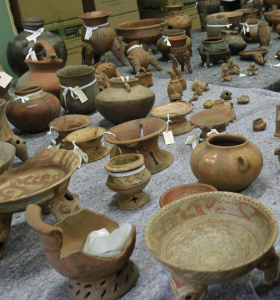Looting has been an obstacle archaeologists have had to deal with worldwide from the very start of archaeological research. Although in a number of countries looters have been arrested and artifacts returned, the overall problem has not decreased.
Social anthropologists started to look at the bigger picture in order to explain why bootleg archaeology has been such an unresolved issue. Instead of just focusing on the looters, they drew their attention to the consumers; as long as there would be a demand for artifacts, there would be looting. Most of the people excavating the sites were doing so in order to create a sustainable income not otherwise available.
In Costa Rica, 4,400 people make at least half of their income from looting, which doesn’t begin to account for all the people involved (Heath, 1973). The huaqueros (people who illegally excavate artifacts from sites) believe the artifacts buried on their soil belong to them and thus believe these are theirs to be exploited. Even while this trade is illegal, border permits are incredibly easy to forge and 95 percent of the trade can still be smuggled (Heath, 1973). This unfortunate situation seems to be because of the lack of archaeology being done and the inclusion of local peoples in the early years of ‘proper’ excavation.

These artifacts were taken in 1896 from one of the only sites excavated in Costa Rica, and were then displayed in a U.S. museum without consent from the locals.
Most sites were not found because of Costa Rica’s tropical forest which covers most surface artifacts. The only people that could potentially identify sites were the locals who did not have a strong connection to their past since most of the population was wiped out during colonial domination. These factors made the possibility of beneficial education on these issues scarce in later years.
Even with all of this in mind, the law still specifically targets the huaqueros although we now know the vast number of people who participate in this trade; police, border patrol, museum curators and many more jobs are involved in the shipment of these artifacts. This group does not even include the consumers who are mostly from the U.S. willing to pay big money for rare artifacts to illegally display in their house or a museum. Continuing to blame the looters will not solve the problem because the threat of jail does not deter someone whose livelihood is based on this trade. In order to eliminate the problem, the demand must be eradicated in some way and the income must be created through a different outlet so that the people involved are not forced into another illegal trade.
Sources:
Heath, Dwight B. “Bootleg Archaeology in Costa Rica.” Archaeology, Vol. 26, No. 3, 1973, pp. 217-219.
Snarskis, Michael Jay. The Archaeology of The Central Atlantic Watershed of Costa Rica. Columbia University, 1978.
Pictures (in order):
http///www.livingabroadincostarica.com/blog/2011/10/returned-ancient-artifacts-go-on-display-in-costa-rica/



